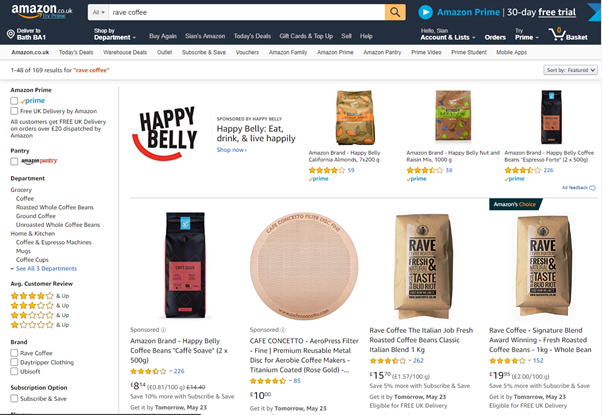Amazon Advertising CPCs remain relatively low compared to Google and Bing. That means Amazon currently presents a huge, largely untapped, advertising opportunity for online retailers.
A recent report from Jumpshot highlighted that more than 50% of product searches begin on Amazon, outnumbering even the mighty Google. So, it’s not surprising that more and more retailers are taking to Amazon to promote their products through advertising.
3 Common Amazon Advertising Mistakes
But how can advertisers be sure their campaigns are performing as well as they could be? Here are three common mistakes we see advertisers making in Amazon Sponsored Ads, and how you can avoid them!
1. Losing on Brand Search
Users who choose to search on Amazon with branded keywords know what they want. They’ve heard of your brand, are familiar with your product and are ready to purchase. But your hard work isn’t over just yet.
These high-intent users are valuable not just to you, but also to your competitors. And you can be sure that if a rival retailer sees an opportunity to get in front of them, they’re going to take it. This is why brand protection within Amazon search results pages is so important.
In this example, the brand search has triggered three competitor ads, one as a Sponsored Brand Ad,
and the others as Sponsored Product Ads taking the first two product slots. For the brand owner to defend these key ad slots, they need to focus on two areas - keyword coverage and bid prices.

Keyword Coverage – Ensure you’re using more than just Exact Match for your brand keyword targeting. Defending the search results for the search term ‘Nike’ is great, but who else is appearing for ‘red Nike trainers’?
Also consider misspelling of your brand name. With the huge volume of mobile search, and the global epidemic of ‘fat thumb syndrome’, it’s important to cover all bases.
Bid Prices – Because users searching with a brand term are already aware of you, they’re likely more inclined to make a purchase. This increased chance of a sale means you should be willing to pay more for their clicks. Brand keywords should therefore have a higher CPC bid than their non-brand counterparts.
2. Shying Away From Automation
‘Automation’, ‘Artificial Intelligence’, and ‘Machine Learning’ are big buzzwords in digital marketing. And for good reason. Although there has previously been trepidation in trusting the robots, it’s hard to argue that current data-driven automation doesn’t work.
Amazon have been improving the opportunity for automation on their platforms over the last 12 months, releasing ‘Dynamic Bidding’ to all advertisers earlier this year.
This bidding opportunity means you can be ahead of the game when it comes to selecting your CPC bids on Amazon. Bid up for searchers who are more likely to convert, and pull back for those where a sale is less likely, all without making any manual changes to your campaigns.
To understand more about how Dynamic Bidding works for Amazon Sponsored Ads, check out Jack’s blog post here >>>
3. Relying On One Targeting Type
There are two ways to approach the targeting of your Amazon Sponsored Ads – manual targeting or automatic. Manual targeting is exactly what it sounds like; manually choosing which keywords, products, or product categories you wish to target. This gives you a huge amount of flexibility and control over where your ads are likely to appear.
In contrast, the automatic targeting option takes away the control. Instead of choosing what to target, Amazon will show your ad in search results and on product pages when it deems relevant to do so.
Automatic targeting removes the need to build keyword lists and add extra search terms when they come about. Instead the strategy relies on Amazon’s huge product and user knowledge, potentially resulting in far more reach.
Both strategies have their pros and cons, but the best approach is always one of combination. Running automatic and manual campaigns side-by-side in an account can reap huge rewards. Manual campaigns allow you to refine your ads to the keywords you know work well, and the automatic campaigns provide scale and can uncover new terms to target.
Relying on just one is like limiting yourself to one scoop of ice cream at a dessert buffet – go for the chocolate AND the vanilla!
Final Thoughts
These are just 3 common mistakes we regularly see in Amazon Advertising campaigns. Getting on top of them means quick wins and potentially big improvements to your Amazon Sponsored Ads.
If you want help optimising your campaigns or just want to talk all things Amazon Advertising, get in touch with the SearchStar team today >>>